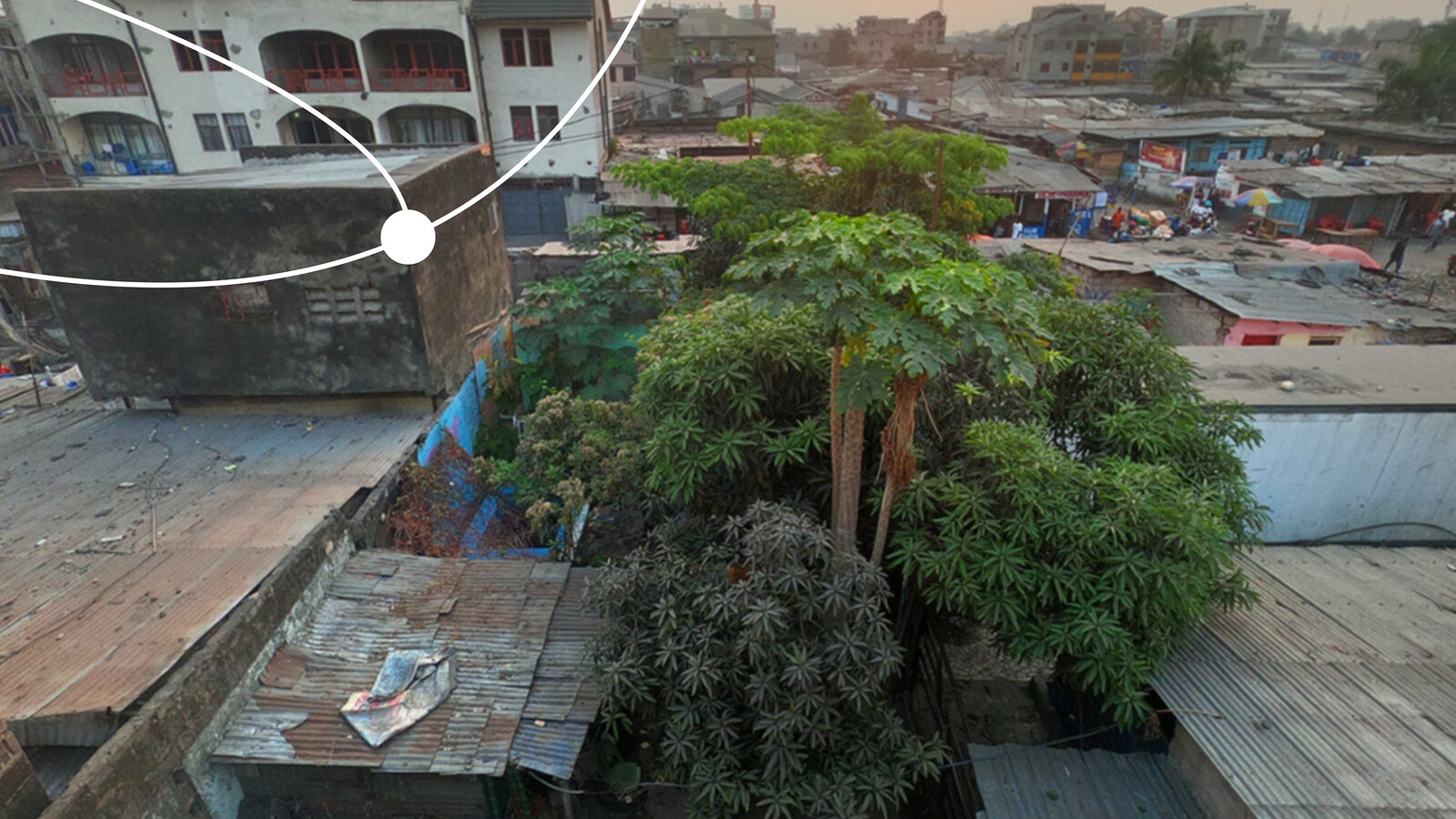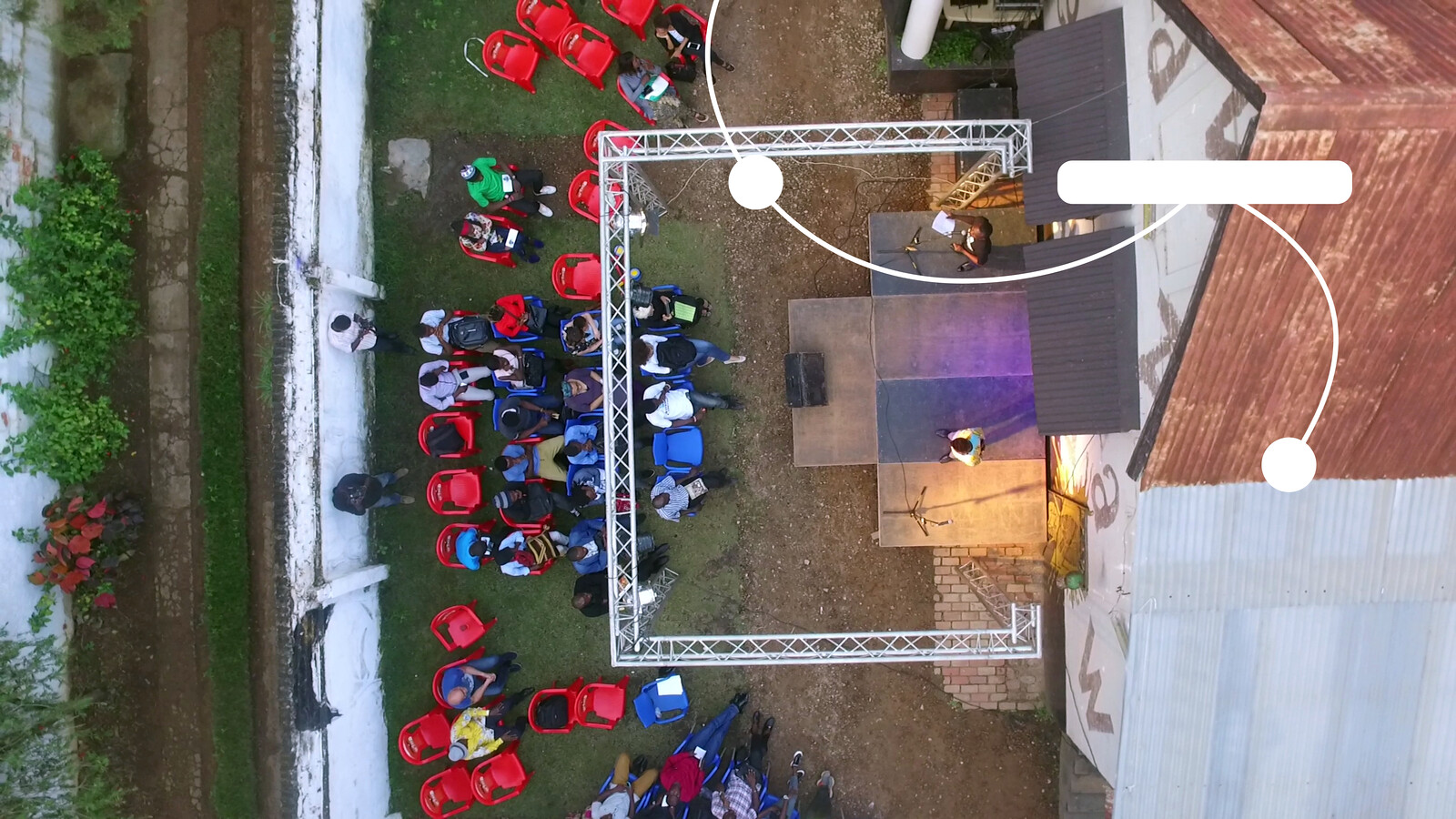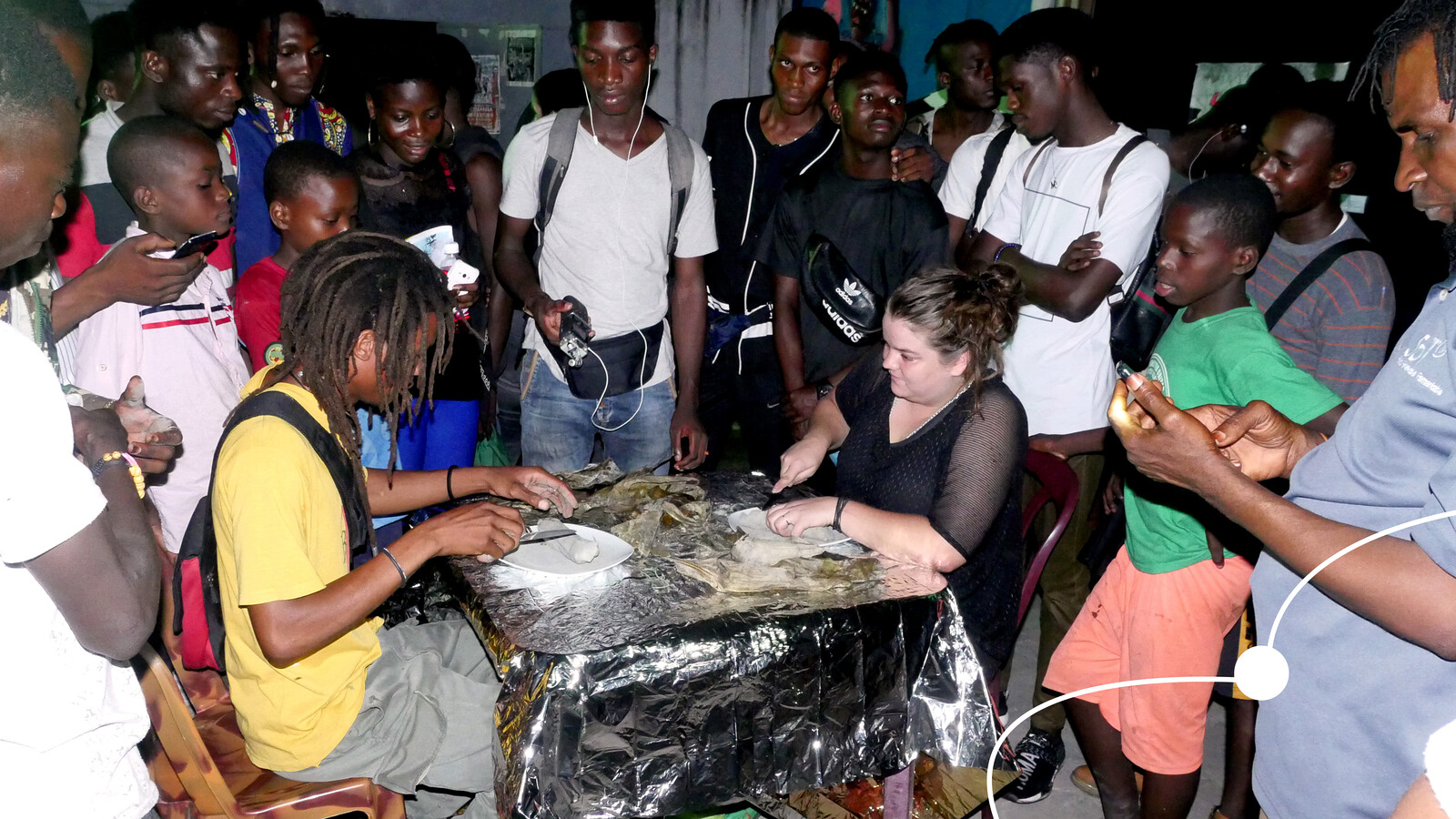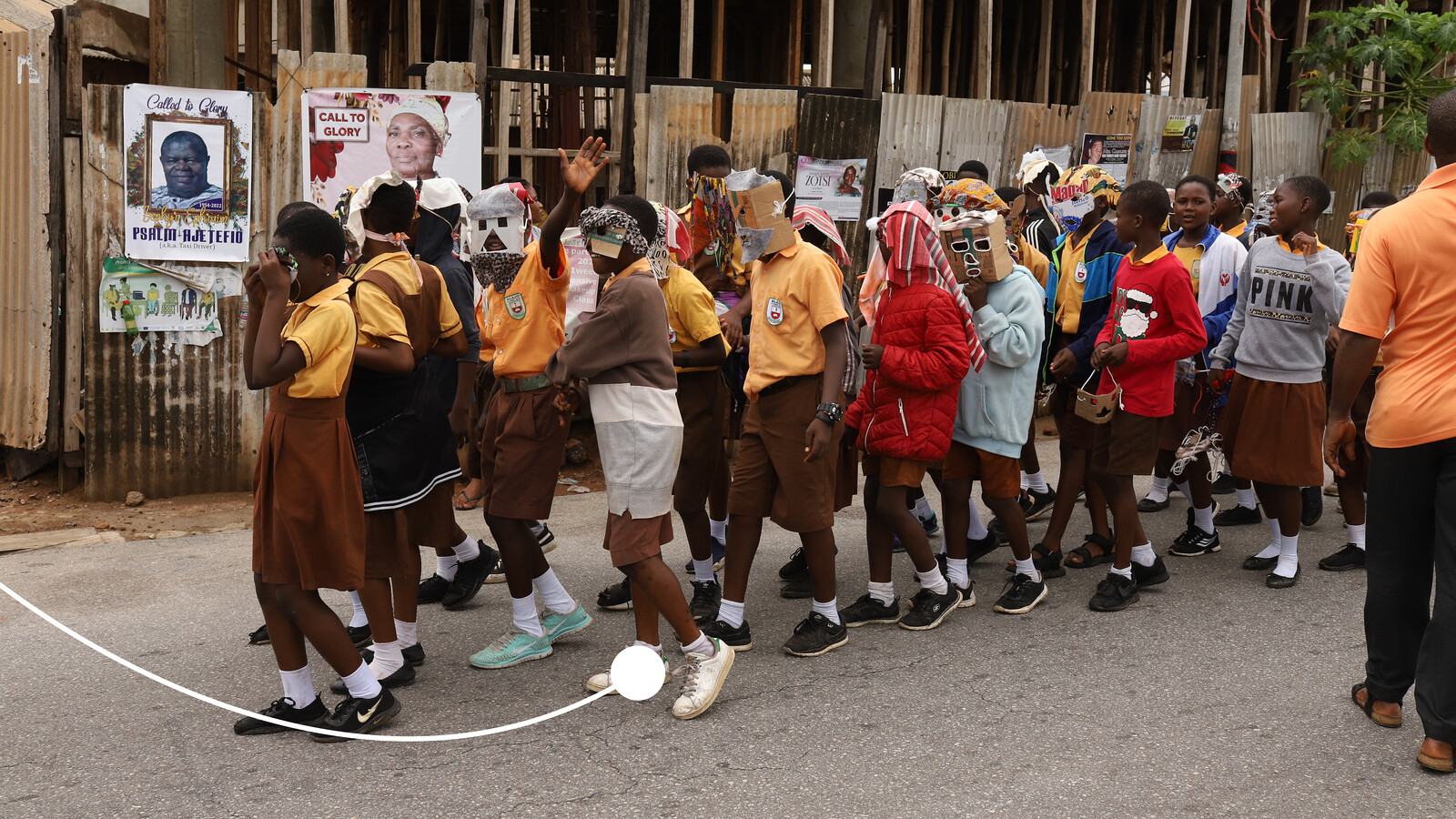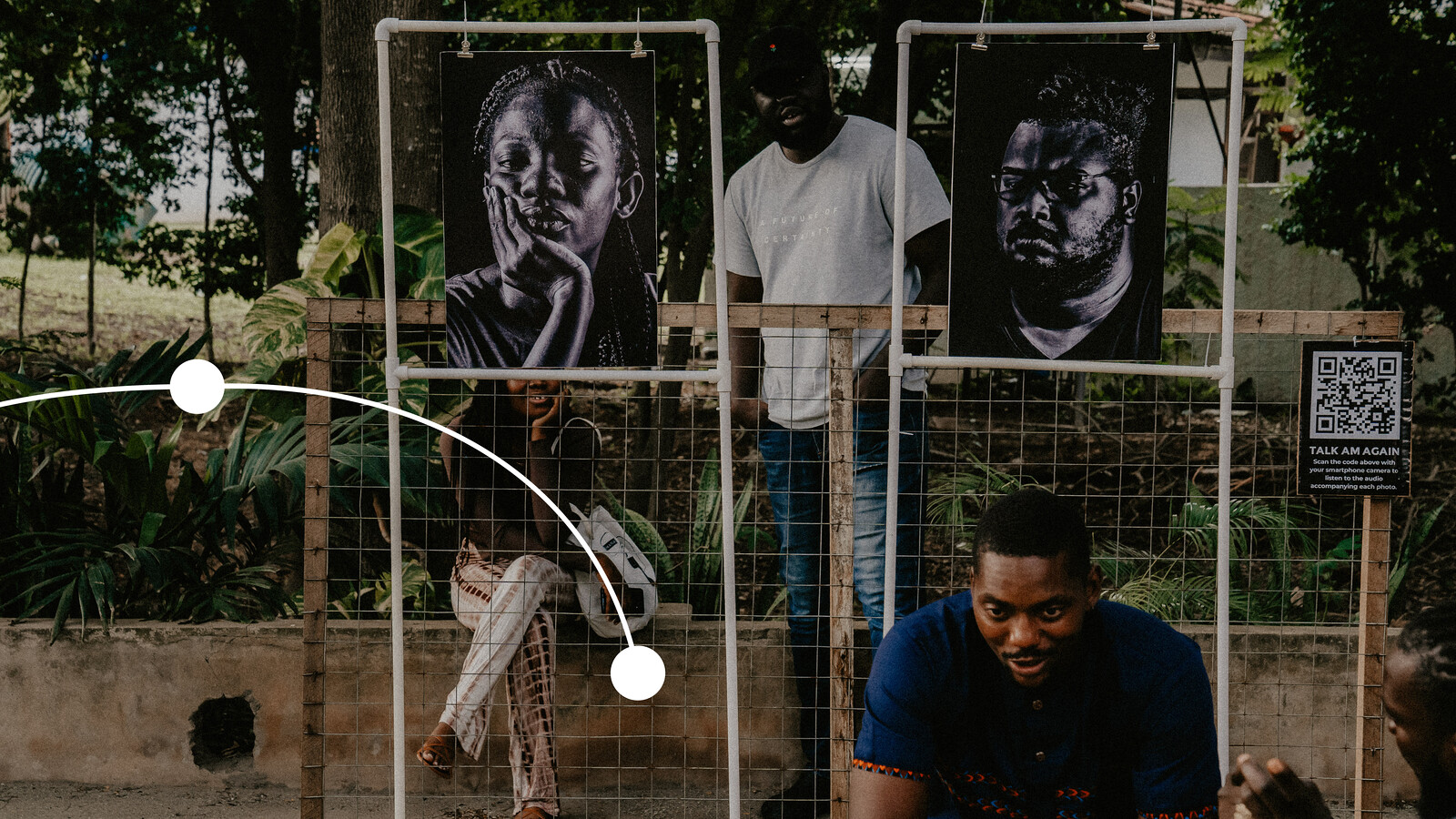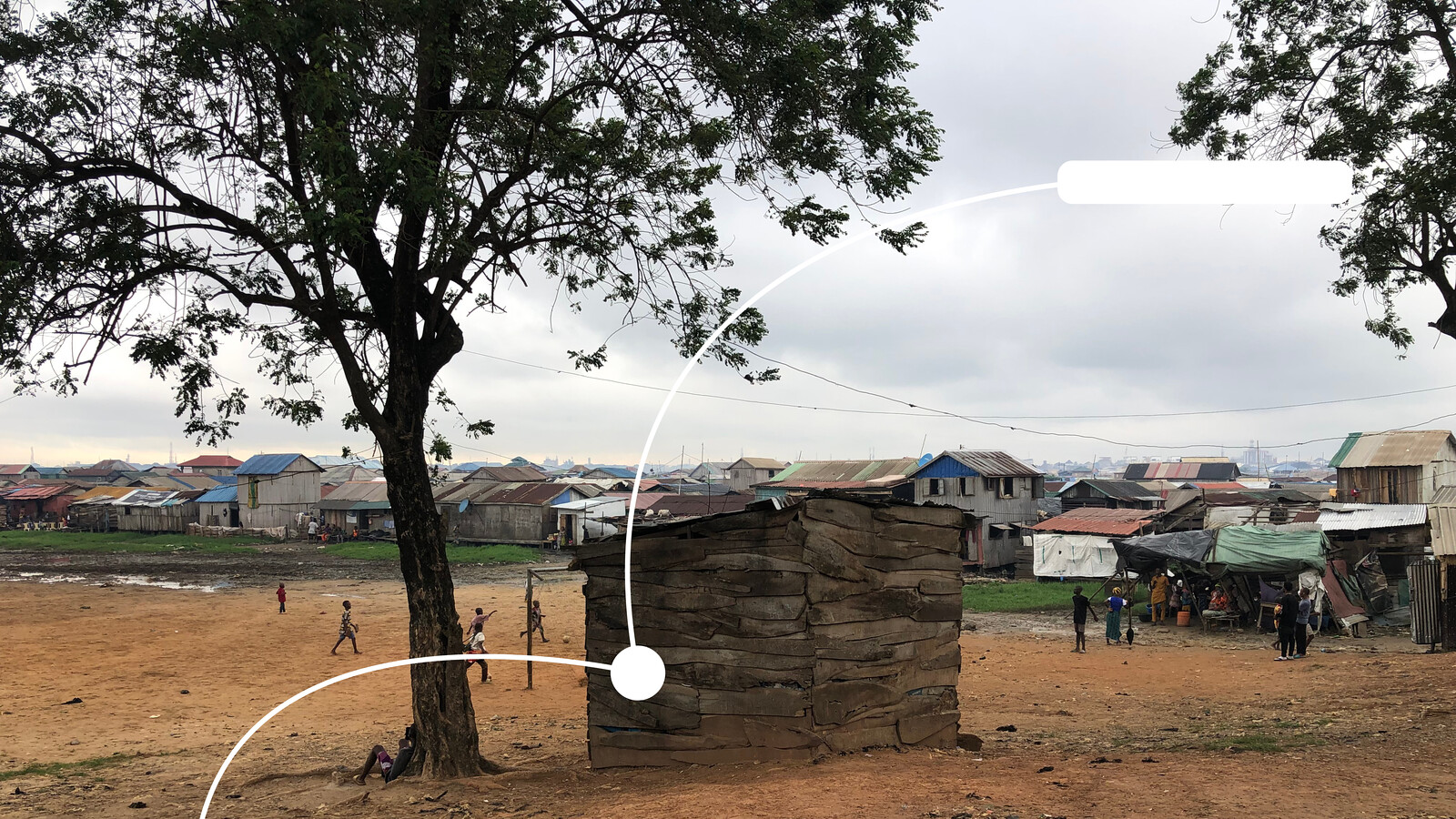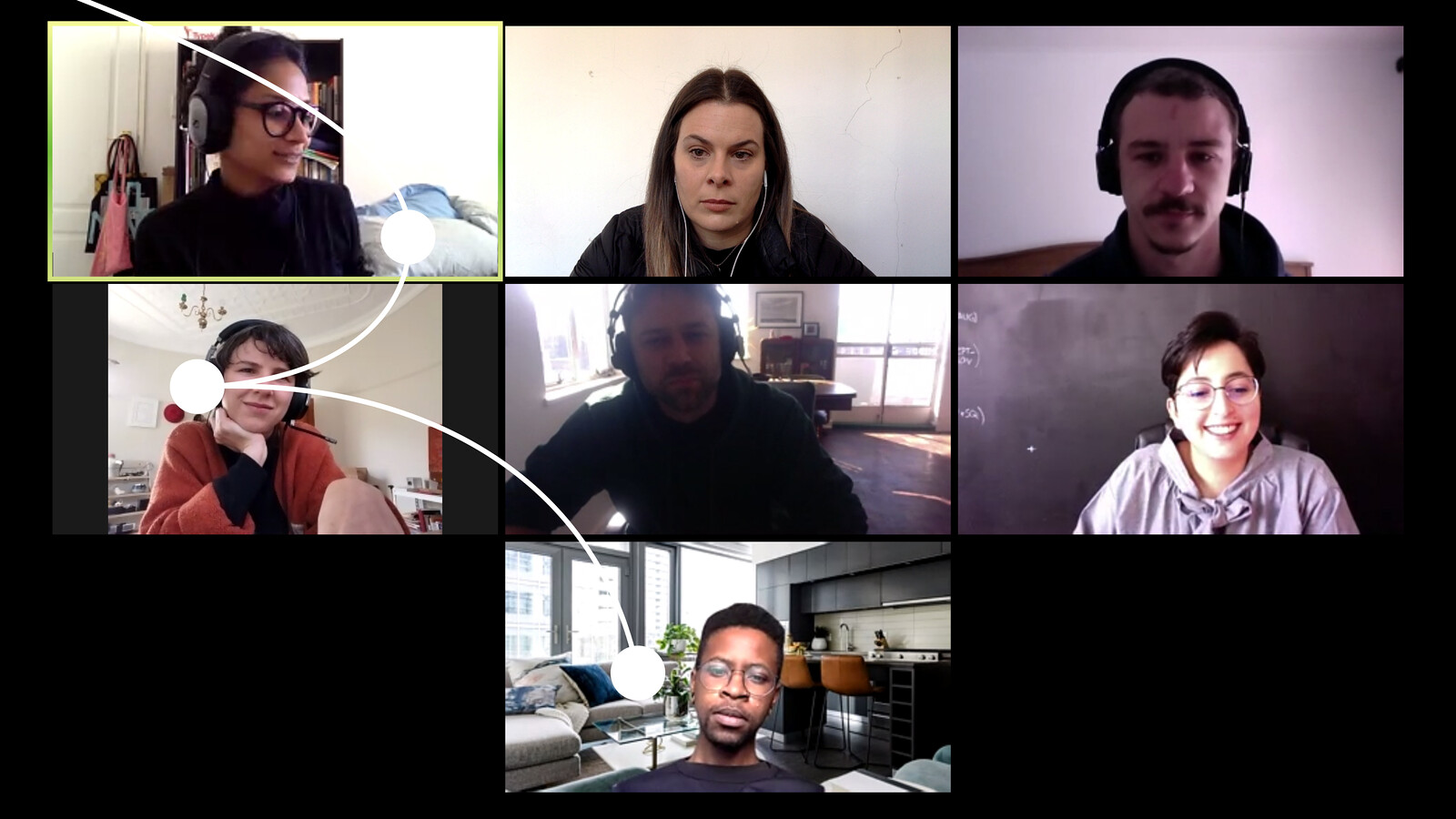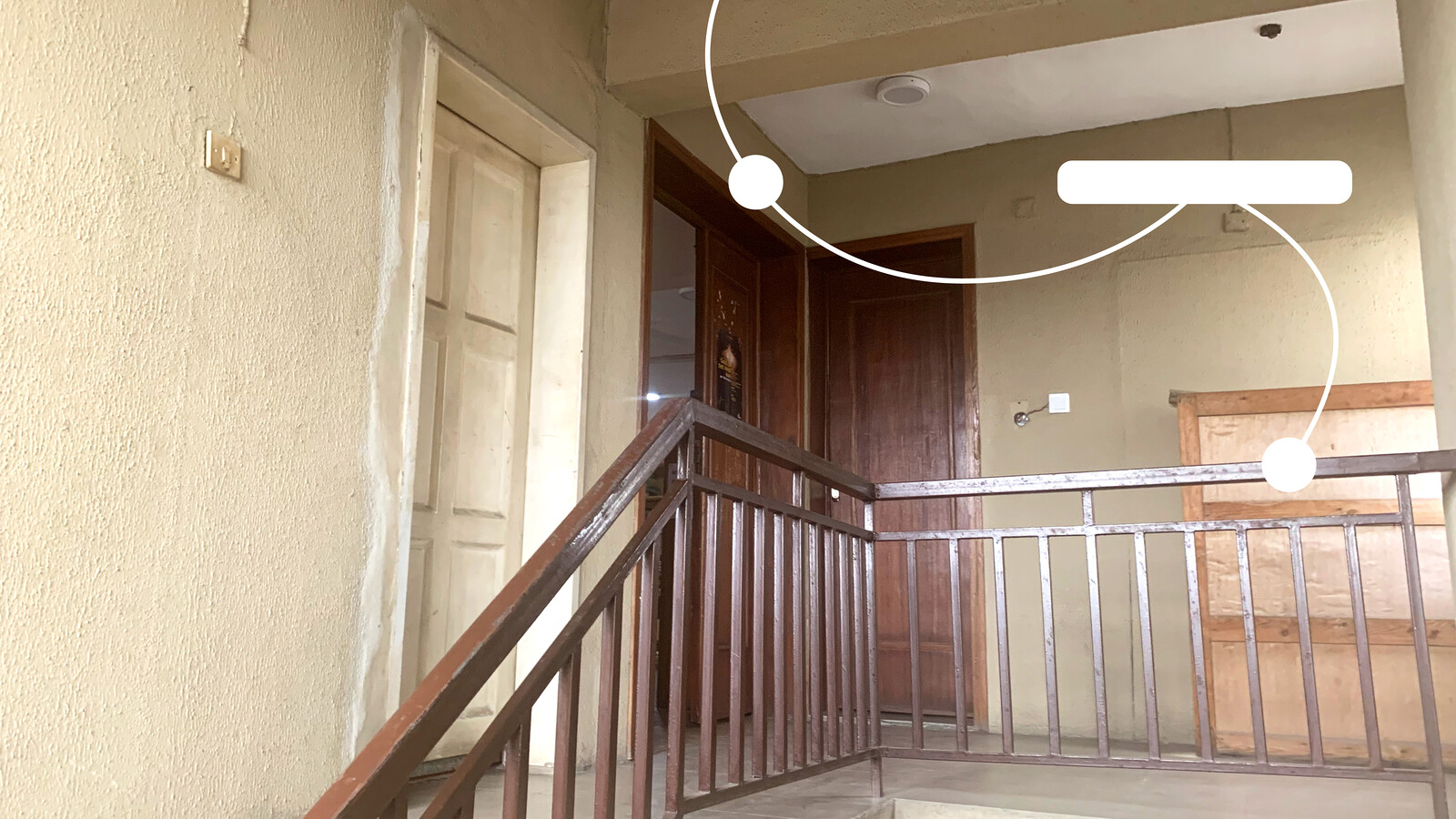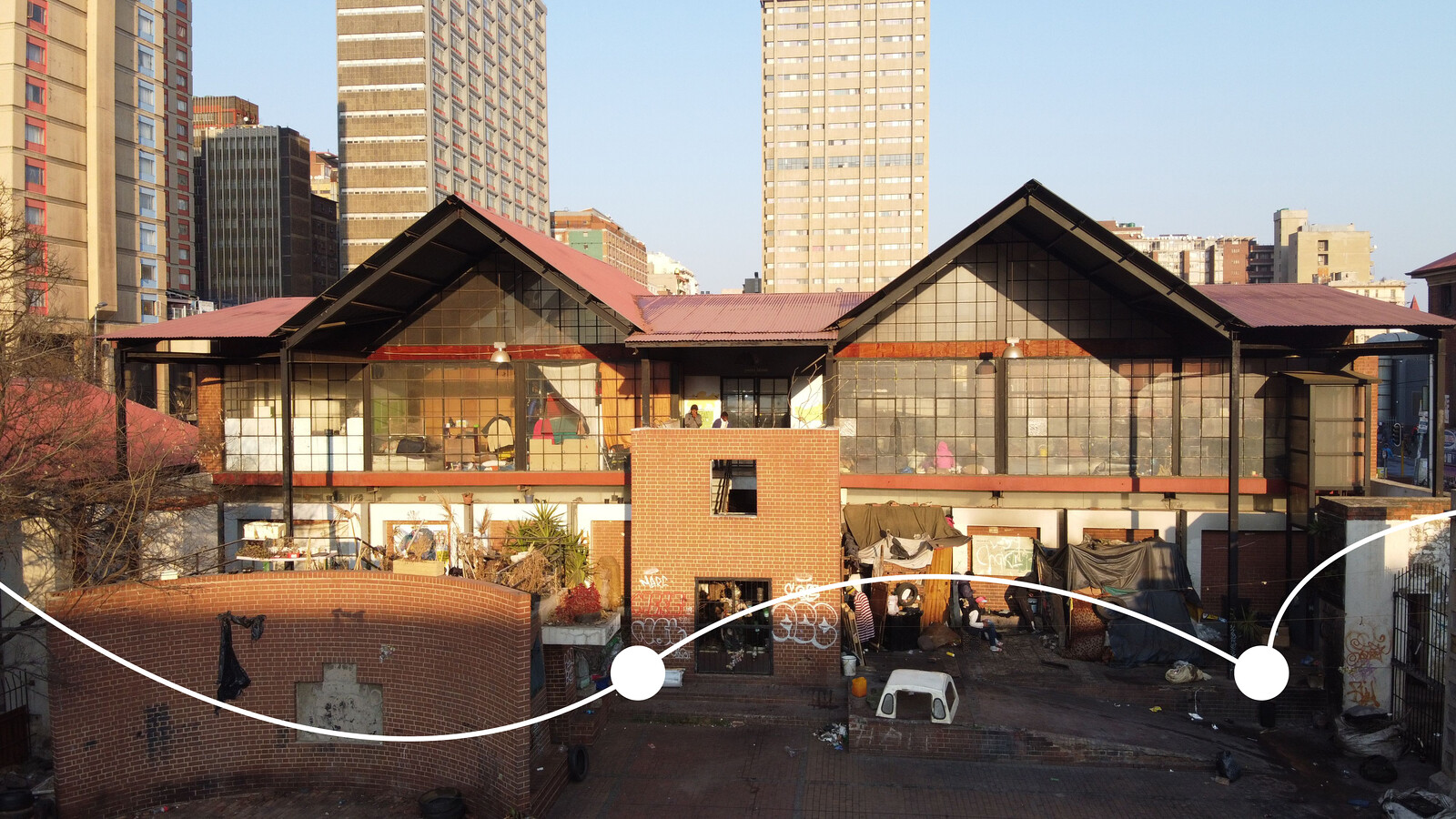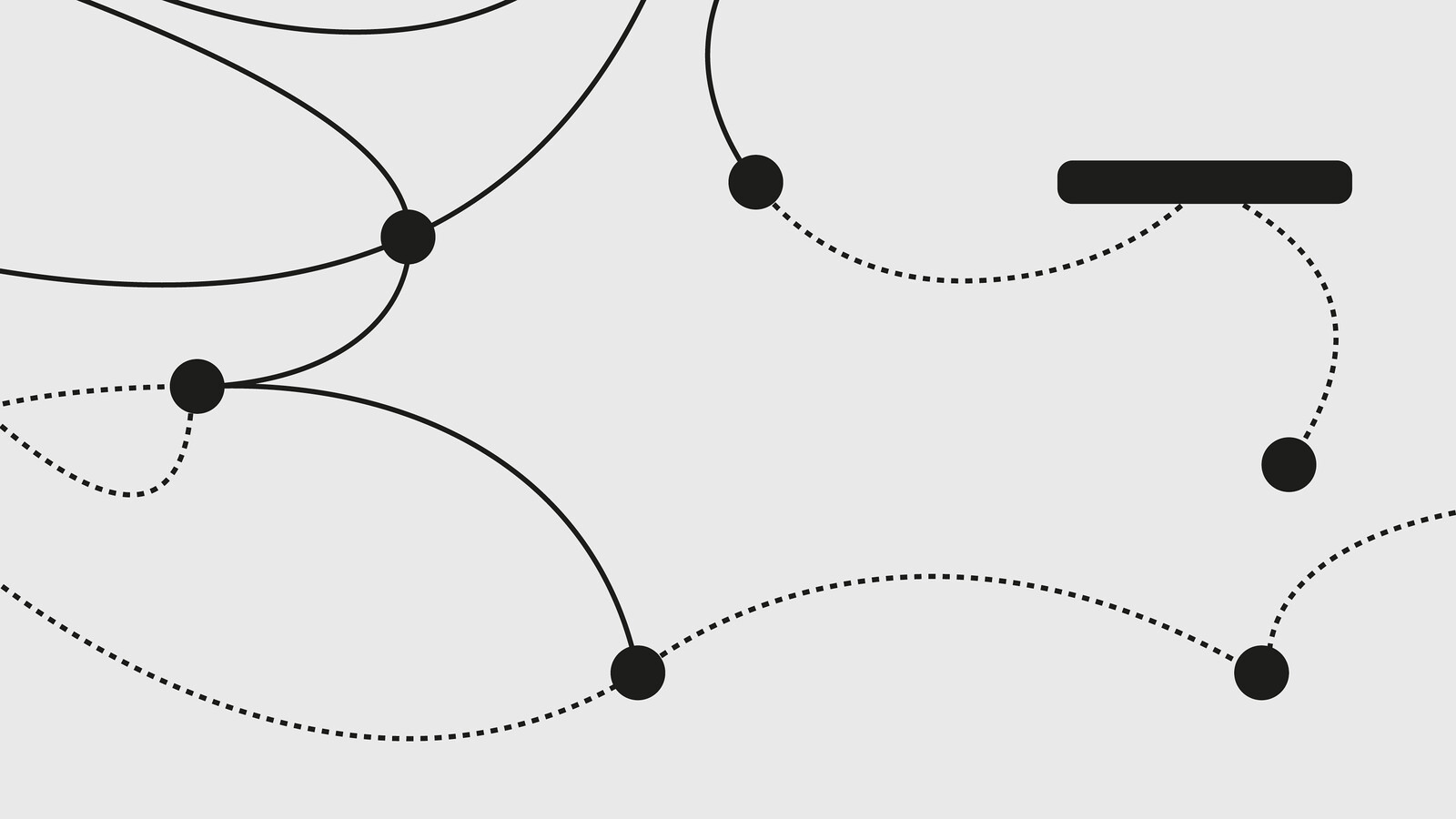Ngbwaka
We’re in the 1990s in Ngbwaka, a district of Kinshasa, capital of the Democratic Republic of Congo. This district was renamed during the Zairianisation period (1971–1997), by the Ngbwaka, a forest people whose territory stretches from the province of Équateur to the north-west of the country and beyond. Originally from this vast region, Bebson Elemba aka Bebson de la Rue is in the process of turning his Ngbwaka home into an autonomous space for collective participatory creation. Step by step, an informal avant-garde will begin to take shape around his artistic practice. His space is near the central market and the zoological gardens. The Zando central market (currently partly closed for poor sanitation) dates to the 1940s. The maze of rutted, bustling, and noisy alleyways is crammed with motley goods that connect Kinshasa to the global market. Displayed in one stand after the next alongside local products are knock-offs of transnational luxury merchandise and a multitude of second-hand articles and bric-à-brac from South Africa, China, Europe, Turkey and the Middle East. Vibrating to the rhythm of innumerable transactions and petty thefts, and to the proselytizing rants of preachers pacing back and forth Bible in hand, the central market acts as a pressure gauge monitoring Kinshasa’s pulse. Bebson Elemba will find here a fluctuating terrain to rethink the world.
The zoological garden dates to the 1930s and hasn’t been renovated in over fifty years, since Belgian Congo days. Barely operating, its decrepit state stands in marked contrast to the grand animal reserve that former President Kabila built in the 2010s on the vast hills along the city’s outskirts. This enchanted park represents an idyllic view of a Congo whose natural resources have been held hostage by multiple extractivisms. In a more apparent but no less problematic way, the old zoo testifies to the predatory logic of the capitalocene. In the cages of the old zoo, which lacks any substantial funding, many of the animals are no longer in good shape. On its edge sits a cultural center called “the zoo—village of artists,” where some former students from the Kinshasa Académie des Beaux-Arts and Congolese “popular” painters sell their work to anyone who is interested. To offer an escape from the surrounding concrete hell and the incessant market gridlock din, Bebson Elemba and other musicians from the area occupy a section of the garden. They come together to sing liberating tunes inspired by Rhythm’n’Blues and Raggamuffin, and in so doing they divert the garden from its zoological compliance.
Ever since the downfall in 1997 of President Mobutu Sese Seko, the sanctifier of Zaire’s authenticity policy and whose authoritarian strides still mark people’s bodies and minds, the Ngbwaka district has gone through a gradual decline. Forcefully hit like the rest of the country by ongoing political conflicts, failing public services, and joblessness, Ngbwaka steadily sank into the ravages of crack, criminality, and prostitution. Its inhabitants were forced to navigate between these troubled waters and the prosperity narrative of flourishing churches thriving on turning Jesus Christ into a highly lucrative superstar. In the midst of this post-industrial evangelized setting, an active matrix unfolds that harnesses resourcefulness and inventive skills, with a capacity for making the temporary permanent. Bebson’s inventive project converges processes of resistance and resilience as a tactic for survival.
Roots & Heritage in Mbandaka
Bebson calls this autonomous creative space Ghetto Kota-Okola, which in English means “Ghetto Get in-Grow up.” It has a vision rooted in Mbandaka, the capital city of the Équateur Province where he was born in 1972 and where he spent part of his childhood. At that time, Bebson enjoyed strolling along the garden byways interconnecting old colonial era homes. Mbandaka’s elders still had a very vivid memories of their history. Sitting in the shade of great trees, tales would be passed down to the young, ensuring intergenerational ties were not broken. They explained their customs, ancestral values, and old rituals like the Ingomba, the rite of passage to adulthood. They also spoke of the arrival of the first whites, including Stanley, Coquilhat, and Vangele, and about the proliferation of missionaries. They also alluded to the most abject periods of rubber exploitation when remembering the Force Publique, the private army established in the Congo Free State of Belgian King Leopold II. Debates raged about independence in 1960 with regrets for Lumumba’s demise. The youth learned the different names given to the city by the colonizers over the decades (Station Equateur, Equateurville, Coquilhatville) until it regained the name Mbandaka in 1966. They spoke of many things, even the hundred-year-old crocodile still imprisoned in the austere enclosure of the Eala Botanical Garden, that chapel of colonial scientism established in 1900 for the purpose of researching, accumulating, inventorying, measuring, and classifying tropical species of plants and trees in order to justify the legitimacy of its existence. Bebson is particularly enthralled when the elders speak of the power of nature and of its spirits, of the sounds and smells of the forest, of the nganga (“healer-diviner”). Sometimes he accompanies his older brother, a wrestler, to other localities, which allows him to travel on the Congo river and its tributaries. Several times champion of Équateur, his brother fights with enormous tamed pythons.
In the Mbandaka high school founded by Belgian missionaries, Bebson was oriented to study to become an electrician, but instead used his new technical skills to design his own inventions. Under Mobutu, his father—a respected, cultivated, and very strict man—is Head of Division of the hygiene department in public services. In 1995, he moves some of his family to a parcel he owns in Ngbwaka. The central market and the zoological gardens are on their doorstep. Bebson grabs any found objects and bargains he can lay his hands on and tinkers with them in his own way. As often as he can, he devotes himself to music, taking refuge in the zoological garden. Much to the displeasure of his father, he is becoming a budding artist. However, the sudden death of this authoritarian father from whom he learned so much will radically shift the course of his life. Bebson and his siblings inherit the parcel. From a fairly strict but relatively comfortable lifestyle, the family sinks into hardship. From then on, Bebson will unleash his creativity according to his own vision, refusing to submit to this twist of fate.
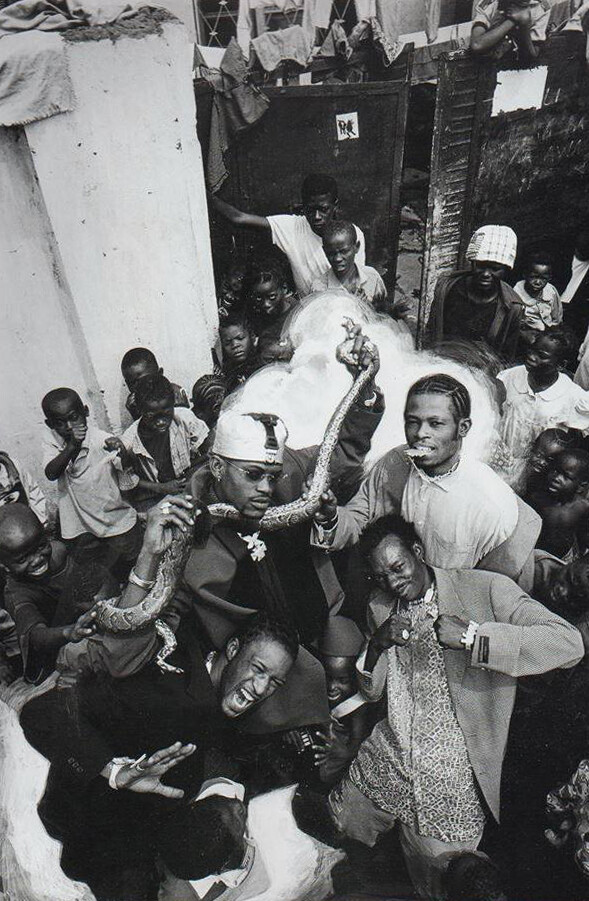

Group photo of TRYONIX, Bebson’s first music band with a python in Kinshasa, 2000. Image: Unknown.
Urban Collective Groove
Very charismatic and gifted in dance and music, Bebson quickly becomes the beating heart of Ngbwaka, involving his neighborhood friends in his creative process. Penniless, no one is able to buy sound systems or instruments. So, Bebson sets out to fabricate them himself. Capable of transforming any object into a poetic celestial body, he succeeds in materializing his wildest dreams. One thing leads to another and Bebson opens his door to anyone who has something to express. Fascinated by his genius and his inexhaustible energy, many kids of Ngbwaka who cannot afford school learn from Bebson by watching him in action. He conceives art from recycled found objects, collected by himself or street children, while empowering them to be makers. Day and night, he works on his creations or accompanies others in their artistic endeavors. Doing so becomes a necessity for him.
Wingi, a Batshwa chief who lives with his family diagonally across the street, always marks his presence. He is also Bebson’s father’s friend. Wingi struggled for a long time to defend the right of “pygmies” to be represented in the Congolese Parliament. Now deceased, he was then one of the mentors of Ghetto Kota-Okola. His older brother, who organizes wrestling tournaments, is also actively involved. Following the death of the family patriarch and the armed conflicts associated with the war in Rwanda that led to the downfall of Mobutu in 1997, Bebson endeavored to recover from all this instability, not only for his own survival but also for the sake of his neighborhood. With the council and participation of wise neighbors, Ghetto Kota-Okola will establish a new balance, an alternative to school, a coeducation system with no classrooms, no desks, and no chalk. Kota-Okola! Get in the groove of creation to grow up! A convocation expressly chosen by Bebson to channel the energies found in the frenzy of urban life, caught in the upheavals of history and his story. The inhabitants of Ngbwaka respond with wit to his call for self-determination. Bebson’s encouragement to restore value to everyone’s personal potential, coupled with his ability to transmit his inner fire, sparked a fertile underground art movement. Ghetto Kota-Okola would become an alternative to the “the zoo—village of artists” and to art schools.


Instruments made by Bebson in Kinshasa, 2009. Image: Kongo Astronauts.
Brakadju Freestyle
It’s the late 1990s and hip hop culture is sweeping through Kinshasa. American hits are sizzling on transistors and small rudimentary TV sets around which residents gather in front of shops or on street corners. Michael Jackson explodes with 2 Bad and Black and White. Fascinated by these sounds coming from the other side of the Atlantic, Bebson immerses himself in the cultural trajectories of Black American music. He listens to reggae from Jamaica that members of the Rastas of Congo Federation turn him on to. French rap hits the airwaves. Bebson’s talents as a dancer and choreographer, a singer-songwriter, composer, and performer transcend Ngbwaka vibes, the urban cultures emerging in the neighborhoods, the traditional music of the Équateur, and these new sounds from abroad. His aural faculties, his memories of natural sounds from his childhood, the noises that pulsate through the capital, and his capacity to reproduce or transmute them, make him a unique artist. He creates kinetic sonic sculptures. To anyone interested, he also reveals the secrets of his electromechanical music machines made from busted appliances that he recycles, drawing inspiration from modern and traditional instruments. Post-industrial whistling, rumbling, rustling, shrillness, crackling; sounds that shatter silence to speak to silence.
Bebson details all the sounds he invents. As examples:
PINCH (English) / BETA FINA (Lingala)
Single-string tin can instrument.
Sound that swims under water, wandering gently and slowly with a memory of reserve, of delay. Notes come ahead of time, bring melody, melancholic sweetness. Sounds sad, makes you want to use it at naptime like a lullaby.
WITHOUT A BADGE (English) / GLING GLING (Lingala)
Guitar in metal and wood.
Vision-board dictated by wise internal inspiration, defining consciousness, tuned for harmony — the final allocution.
CUE PANEL (English) / BENDELE (symbol that says a person lives here) (Lingala)
Metal and wood cymbal
Kaws like a crow, as a blackmailing medicine man (wanganga). Open or closed to alter its pitch.
Bebson sets up spaces, structures, and installations that combine raw DIY with a glamor and elaborate psychedelic agency that is reminiscent of Mbandaka’s hybrid built environment, which mixed colonial and traditional architecture with contemporary recycled materials. Eccentric and uninhibited, Bebson performs the turmoil of the world in mind-blowing collective scenes that unify the neighborhood. He usually expresses himself in his native language, classic Lingala, with back-to-back parables. He incorporates French using puns based on the sonorities of the two languages and participates in this way in the development of Langila, a coded language spoken by street children and some intellectual devotees of a living and creative orality. He is one of the masters of Kinshasa’s DIY. In our long conversations since 2006—the two of us connected by many affinities, common projects, and a deep friendship—we named this artistic movement BraKaDju, an old word describing the art of creating long rhythmic improvisations on percussion instruments. According to Bebson, Ngbwaka freestyle applies to all arts that make the heart travel.
Kota-Okola can be seen as a work of art with multiple functions unfolding over time in the extreme conditions of this neighborhood where art and life merge. Bebson’s parcel is a veritable rallying spot for those with vibrant minds who’ve been neglected by neoliberal systems of power and its shape-shifting tentacles. Many children cast aside by the force of disasters find their way to this intergalactic shelter. The place brings much needed joy to build and rebuild oneself. This birthplace of experimental Congolese rap and hip hop, an alternative scene in the 1990s and 2000s, continues to inspire artists today under the umbrella of urban music. We see this in Pisco Crane’s original Fulu Miziki, in Boms Bomolo, and Love Lokombe’s original Kokoko, and in the “timbela ba timbelayo” recording studio created by Esto Njonjo, to name a few examples across the arts.
Bebson and his Ghetto Kota-Okola faced a great deal of economic, political, social, and familial turmoil. These crises were overcome without subsidies from the state, without international support, and without an official status, but rather through the sheer determination to create a collective synergy adapted to the realities of a grueling urban context. Many young people escaped delinquency thanks to this initiative and despite the shortcomings of governance. Ghetto Kota-Okola has held Ngbwaka’s world together.
Feedback Loop
In the early 2000s, things change. Bebson’s creative power and magnetism earn him support from the French Institute of Kinshasa. For a few years, he moves a part of his coeducation system into the Institute’s premises. This will enhance his aura beyond the confines of Ngbwaka. Foreign artists-in-residence at the institute invite him to collaborate on music and theater projects. Unfortunately, not all these initiatives are necessarily in his groove, but he is keen to discover other realities. These interactions are a portal to other ways of thinking. They also interrupted Kota-Okola activities in Ngbwaka for long periods of time. Bebson doesn’t regret it. Experiencing the divides between Africa and Europe enable him to position himself with greater insight into contemporary social planetary complexities .
Many young people, not much younger than he, were empowered by this informal initiative to become self-sufficient. Bebson fostered a great number of recycling and assemblage activists in the neighborhood. The most dedicated among them developed very personal approaches based on their Kota-Okola experiences, while retaining in their work some elements of Bebson’s magic. Sometimes this was evident in a particular way of singing, or in the re-appropriation and transformation of everyday objects, or in the musical instruments they invented, or in the art of donning costumes and performing. Some nearly identical copies of his singular creations are circulating and are even presented as being realized by emerging artists in exhibitions, festivals, clips, or other public art actions. One wonders whether these copies diminish Bebson’s undertaking, or promote Ngbwaka’s dissemination of the BraKaDju spirit. Surely, this depends of the motivations of the imitators, and on the recognition and the income that they receive, from which Bebson himself does not benefit. But then again, isn’t it Bebson’s heartfelt desire to sow the seeds of transformation? To ensure everyone can make it? His artistic orientation challenges academia and the influences of Zaire authenticity, but he does not concern himself with these ambivalences; he acts.


CAR-GUITAR for a sound performance by Bebson as a spooned Darth Vader in Kinshasa, 2014. Image: Kongo Astronauts.
Now-Edge
Bebson has the heft to become an international music star, but showbiz is a world filled with imperialist ambiguities. He may have dreamed of stardom, but he has resisted dominant systems. He did so nearly in spite of himself, because he’s unclassifiable and sometimes proves to be elusive to those who try to conquer his impetus. Getting into showbiz would have thrust him into inevitably unequal power relations. Bebson rebounds off screen regardless of any proposals (even though he is the focus of several films). The ultimate sound and visual poet, child of Congo ancestors, of U-Roy and of John Cage, behind his Darth Vader mask wound with spoons, Bebson ignited all who came near.
Regime shifts and digital disruption have modified the urban landscapes of Congolese creation. Many venues subsidized by foreign bodies have sprung up. The local contemporary artistic elite are entering the international art market and find themselves somewhat bewildered by the indescribable “total work of art” born from the simmering streets of Ngbwaka. Others, on the contrary, have taken hold of Kota-Okola’s powerful visions, oblivious to the depth of the approach as they set out to pursue what are probably more enviable survival strategies. Kota-Okola remains a form of resistance to acculturation processes in underprivileged neighborhoods, but also to the institutionalization of art, whose artefacts it undermines with disconcerting creativity. Bebson was not, to be sure, the only artist to practice the art of recycling, but he is undeniably a leader and an aesthete in the field. He brought together an entire neighborhood around his cross-disciplinary practice. The strength of Kota-Okola is a processual journey whose equilibrium has always been fragile, adapting to uncertainties and resisting energy drain, fighting for the right to live, to dream, and to express, without having to intellectualize according to a Western model, navigating instead between the drawbacks of its complexity.
Kinshasa is today confronted with “Bombe.” This substance, even more toxic than crack has taken the destitute youth by storm, pushing them into very dark spots, ostracizing them to a zombie-like state that annihilates any inclination to self-determination. Ngbwaka hasn’t been spared. Despite the extent of this new carnage of the youth, Bebson and the elders of Kota-Okola remain like a lighthouse in Ngbwaka. With insight and courage, they face all the permutations of this chronic adversity.
Overground
Beyond all these considerations, Ghetto Kota-Okola’s hyperactivity, its tenacity, and its ability to transform a hostile environment has given a monumental vital force to the art world of Kinshasa. It continues after thirty years to unlock the senses and memories. Bebson’s corner was enlarged by force of circumstance, following an attempt by others to steal his family’s property by destroying homes on their parcel. Fortunately, they were able to get it back. He planted many fruit trees and edible plants to promote food self-sufficiency. He must be the only one doing this so close to the center of the city, where ongoing rampant construction dominates. Bebson welcomes all those who wish to come share in moments of art and life, provided they are willing to follow the laws of his eclipses, his outbursts, and his detours. A small blue tiled pool that he built gives the neighborhood children a place to come and laugh and cool off while they learn how to dive. Turtles and fish can also be found there from time to time. He continues his work to the rhythm of his desires and pursues his explorations with others. We continue to converse about Kota-Okola, about the young people we have sometimes supported together, and about our film performances. Performance is a practice that he, I, and others have contributed to re-awakening in Kinshasa. As one of our co-pilots, Bebson regularly appears in Kongo Astronauts actions, a collective of artists and thinkers I co-founded with Michel Ekeba in 2013.
Ghetto Kota-Okola is an oasis that hovers like a botanical spaceship over Ngbwaka, and from where one can see the twilight of a philosophical trance. There’s plenty to meditate in the permanent movement of creation. The Ghetto Kota-Okola, or “Chez Bebson de la rue,” sustains its flow.
Interdependence is a collaboration between e-flux Architecture and OtherNetwork, a project by ifa (Institut für Auslandsbeziehungen) together with cookies.
